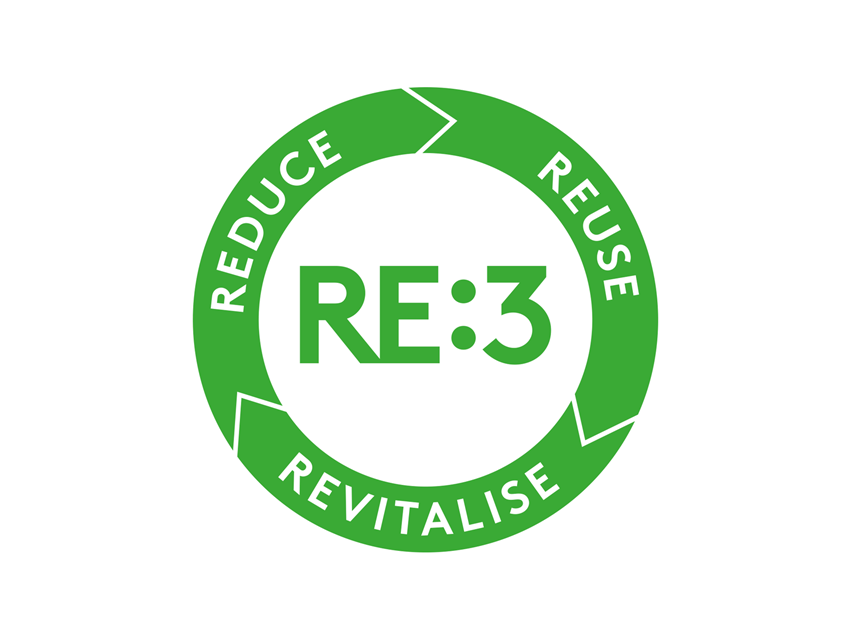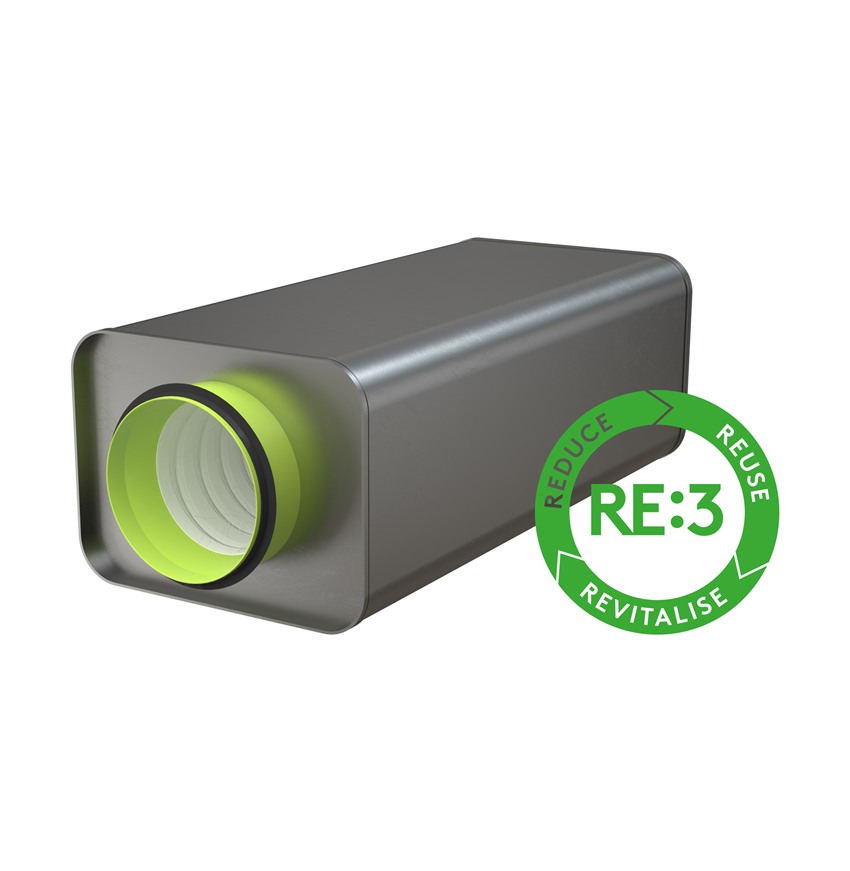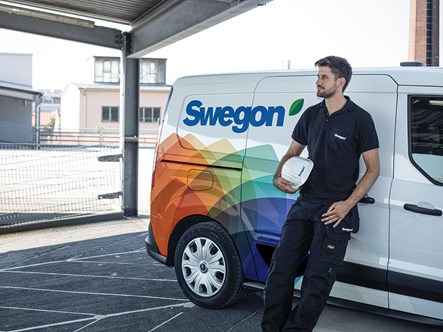RE:3 – a concept to RE:duce, RE:use and RE:vitalise
RE:3 is a Swegon concept, based on the key principles of circularity, which consists of RE:duce, RE:use and RE:vitalise. This unique approach is believed to contribute significantly to the industry and simplify for a wide audience to make conscious and long term decisions in regards to lowered embodied carbon levels in buildings. A RE:3 solution is an alternative to our conventional products, systems and services, an alternative which is reduced, reused or revitalised. We ensure a notably lower level of embodied carbon, built-in CO2, and let these solutions wear our RE:3 symbol.
Operational carbon and embodied carbon
At Swegon, we divide our sustainability work in social, environmental and economic aspects, often referred to as people, planet and profit. In this section we will discuss carbon dioxide (CO2), and the measures to minimise the emissions thereof, carbon dioxide is categorised as ‘planet’.
The focal point of our work, as for many other companies and governmental bodies, has so far been to find ways to reduce the operational carbon footprint – in our case minimising the energy used for ventilation, heating and cooling in buildings. However, we recognise a need and maturity to also address embodied carbon. Embodied carbon encompasses emissions from manufacturing, transportation, installation, maintenance, and disposal of building materials. All suppliers need to think differently going forward in order to reduce these emissions, and at Swegon we gather pioneering alternatives to the standard way of working in our RE:3 concept.
About people, planet, profit on our corporate site

RE:3 and circularity
RE:3 today builds on the fundamentals of circularity which can, in a simple but fair way, be described as the contrary to the use of materials in a linear way. Instead of taking, making and disposing, it means using materials in circular flows where the ultimate goal is to eliminate waste. Repair, upgrade and renovate, re-use, face-lift and design for disassembly are activities often used in the context of circular economy. We focus our RE:3 initiatives to RE:duce, RE:use and RE:vitalise which are defined below:
RE:duce – the use of materials containing substantial levels embodied carbon is to be reduced through the use of alternative constituents, or through a new design that is adapted to lower the embodied carbon.
RE:use – products are to be taken back, refurbished or upgraded and made available to the market once again.
RE:vitalise – products are to be updated on site which allows for an extended lifetime as well as modern functionality, however, this does not refer to traditional spare parts sales or general service and maintenance.
In connection to the above, we want to point out that providing maintenance and repairs is also cruical from a circularity perspective, and continues alongside the advancements under the RE:3 concept.
A framework for the concept
With embodied carbon not being traditionally prioritised within the building sector, the RE:3 concept might need some further explanation in regards to its purpose and limitation:
- RE:3 is limited to embodied carbon
- It is concentrated to products and the installation phase, excluding the operational phase which for instance involve energy efficiency.
Or simply - whenever a Swegon product is marked with the RE:3 symbol, it is a product which reduces the level of built-in CO2 in a building. However, the RE:3 symbol is not a certification, it is a marking to guide our customers among our offered products.
Further, when defining RE:3 the agility of the concept is important to mention. When the alternatives become standard, they will no longer wear the RE:3 symbol, but rather be the ordinary options from us at Swegon. Last but not least, we remain committed to circularity and continue to develop and promote circular practices alongside the advancements under the RE:3 concept.
Examples of how RE:duce makes a difference
STEEL
This part of the RE:3 concept is focused to reducing the use of materials containing substantial levels of embodied carbon.
A first example within the RE:duce scope, is the introduction of steel with a reduced carbon footprint. This is under implementation in our GOLD air handling units, and integrated in the production of our CLA sound attenuators.
We are using steel with at least 75% recycled content ratio, in addition, it has been processed using only electric arc furnaces operated with renewable energy. The outcome is steel with a substantially reduced carbon footprint compared to traditional steel which allows for a notable reduction of embodied carbon. In our Swegon GOLD air handling units the reduction is up to 20%, depending the amount of replaced steel, and in our CLA attenuators, 34% reduction.
Read our expert's blog about the steel used today
Learn more about our Swegon CLA

REFRIGERANTS
Another example within the RE:duce scope is the significant improvements made as conventional synthetic refrigerants in heat pumps and multi-functional units are exchanged for the natural alternative of propane. Several refrigerants in common use are extremely harmful in terms of their global warming potential (GWP). They may be excellent as refrigerants, but if emitted, they constitute numerous greenhouse gases, some manyfold worse for the environment than carbon dioxide. On the contrary, propane as a natural refrigerant has a GWP of 0. This replacement, contribute to a considerable reduction of the carbon footprint of heating and cooling equipment and we align our work with the commitment to environmentally responsible practices. Learn more in our experts’ blog posts below:
RE:use – what is our ambition?
When renovating or refurbishing a building, it is not uncommon that fully functioning equipment is scrapped, and replaced with brand new, just because requirements for the indoor climate have changed. Some building material, like bricks, windows or bathroom fixtures, may relatively easily be re-installed in another buildings. But what about more complex products, such as ventilation equipment?
At Swegon, we have initiated and joined a set of pilot projects which aim to establish solid paths for future reuse of heating, ventilation and air conditioning (HVAC) units and systems. We want to find a large-scale way of taking back existing equipment, and after clean-up, component upgrades and final quality checks, offer it to the market again. From a functional perspective the product will be on-par with a brand new, and the carbon footprint will be significantly reduced. An approach with clear advantages compared to using products second hand.
Stay tuned to follow our RE:use initiative towards a more circular economy.
Not to reuse is a huge waste, but this change requires both ourselves and our customers to think differently - and we are well on our wayAndreas Örje Wellstam, CEO Swegon Group
RE:vitalise – extends the product's life cycle
As the title reveals, RE:vitalise is when products get an extended lifespan. This is done by making component updates and adding modern functionality to the products. The difference between RE:vitalise and traditional spare part replacement or routine maintenance is the projected 10-20 extra years of operational time the revitalised products get.
Within the RE:3 framework, RE:vitalise stands out as the most effective way to reduce embodied carbon, This because all products remain in place, significantly fewer and smaller transports are needed and only necessary components are newly produced, not entire units.
RE:vitalise in practise
Update and digital renovation
To exemplify, while our Swegon GOLD air handling units are renowned for their long service life, some components will naturally be worn out. While the mechanical structure may hold-up for decades, advances in information technology means the software and digital interfaces may become dated more quickly. Through easy replacement of key components and by the means of software updates, the unit is given a continued service life and is actually smarter than it was initially intended to be.
On the same note, the controls of our Swegon WISE system for demand controlled ventilation can be updated, and with that, be compatible with a the latest WISE generation platform. This update retains most of the existing hardware in place while the system is considerably modernised.
Get familiar with our Swegon GOLD update
More about digital renovations of WISE systemsExplore further
Presented below is a set of related subjects to learn more
